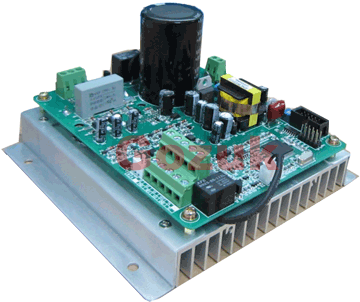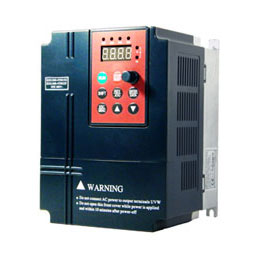Why use Variable Frequency Drive for induction motor?
Electric vehicles can use many kinds of drives but an induction motor has with the development of voltage vector control and field weakening a good advantage. The control is more difficult but this is solved by the constant improvement of the speed and calculating power of modern processors. This is why using VFD to control an induction motor was a good idea. It gives the possibility to use it to show people about the control of an induction motor and the step towards electric cars is easily made. In the variable frequency drive itself are the most basic components present. Because of the DC-link it is possible to look at these parts separately and do experiments on them. There is a whole gamma of experiments that can be done; measurement of harmonics for different load situations, voltages and frequencies; measurement of load curves; DC powering; looking at the impact of different parameters in the variable frequency drive; regenerative braking etc.
For me this work was a very good opportunity to work quasi alone at a task. By means of this article and the preliminary literature project I received a good idea what it is to do research. The fact that I could work together with a Chinese student with a different background made it an unique experience. Here I could find out what it was to explain and 'teach' somebody else about: the field of my interest, electrotechnics. The biggest problem we had, was the time. We ordered a VFD for 220V but it would take too long to get this one. Therefore the people of Gozuk in China gave us a variable frequency drive for 380V with a good discount. This made that we could start experimenting the next day after ordering. But because of the high voltage it wasn't save and/or smart to work alone at the practical experiments. Christer, my colleague, had only time at Thursday and Friday so this became a problem. That's why we hadn't the chance to do many experiments. We were pretty excited about a DC connection we established. We actually drove the motor on DC voltage. But after a while it became clear that this wasn't ideal. To protect all the components, everything had to be in series and/or parallel. Even when building this up perfectly, the danger for us as persons was to high. For instance if the DC- link was connected with the opposite polarity a voltage of 1080 V was present. We abandoned this experiment and looked for possibilities of a flying wheel. This took time to derive and find a right implementation in the work house. Because of the limited time we cancelled this project. After that we had problems to use the graphs of the fluke power meter in a printer or computer. The last week of my stay in the lab I tried to do the experiments again and just fotograph the diagrams but unfortunately I hadn't access to the cupboards with meters. Actual measurement data is missing. This paper is by that in the first place a theoretic report about the control of using a VFD on an induction motor.
For me this work was a very good opportunity to work quasi alone at a task. By means of this article and the preliminary literature project I received a good idea what it is to do research. The fact that I could work together with a Chinese student with a different background made it an unique experience. Here I could find out what it was to explain and 'teach' somebody else about: the field of my interest, electrotechnics. The biggest problem we had, was the time. We ordered a VFD for 220V but it would take too long to get this one. Therefore the people of Gozuk in China gave us a variable frequency drive for 380V with a good discount. This made that we could start experimenting the next day after ordering. But because of the high voltage it wasn't save and/or smart to work alone at the practical experiments. Christer, my colleague, had only time at Thursday and Friday so this became a problem. That's why we hadn't the chance to do many experiments. We were pretty excited about a DC connection we established. We actually drove the motor on DC voltage. But after a while it became clear that this wasn't ideal. To protect all the components, everything had to be in series and/or parallel. Even when building this up perfectly, the danger for us as persons was to high. For instance if the DC- link was connected with the opposite polarity a voltage of 1080 V was present. We abandoned this experiment and looked for possibilities of a flying wheel. This took time to derive and find a right implementation in the work house. Because of the limited time we cancelled this project. After that we had problems to use the graphs of the fluke power meter in a printer or computer. The last week of my stay in the lab I tried to do the experiments again and just fotograph the diagrams but unfortunately I hadn't access to the cupboards with meters. Actual measurement data is missing. This paper is by that in the first place a theoretic report about the control of using a VFD on an induction motor.
Post a Comment:
You may also like:
Featured Articles
Non-Enclosure Variable Frequency Drive ...
 No enclosure (cover), reducing installation space and cost effective. Widely used in All-In-One control cabinet. Keep the same ...
No enclosure (cover), reducing installation space and cost effective. Widely used in All-In-One control cabinet. Keep the same ...
 No enclosure (cover), reducing installation space and cost effective. Widely used in All-In-One control cabinet. Keep the same ...
No enclosure (cover), reducing installation space and cost effective. Widely used in All-In-One control cabinet. Keep the same ...Variable frequency drive application ...
 Variable Frequency Drive (VFD) can be used in lots of fields. Variable frequency drives are widely used to control the speed of ...
Variable Frequency Drive (VFD) can be used in lots of fields. Variable frequency drives are widely used to control the speed of ...
 Variable Frequency Drive (VFD) can be used in lots of fields. Variable frequency drives are widely used to control the speed of ...
Variable Frequency Drive (VFD) can be used in lots of fields. Variable frequency drives are widely used to control the speed of ...Variable frequency drive in HVAC ...
 Variable frequency drives (VFD) have been used for HVAC systems in buildings for more than 40 years. But only in recent years, ...
Variable frequency drives (VFD) have been used for HVAC systems in buildings for more than 40 years. But only in recent years, ...
 Variable frequency drives (VFD) have been used for HVAC systems in buildings for more than 40 years. But only in recent years, ...
Variable frequency drives (VFD) have been used for HVAC systems in buildings for more than 40 years. But only in recent years, ...Variable Frequency Drive Harmonics and ...
A discussion of the benefits of variable frequency drives often leads to a question regarding electrical harmonic distortion ...
Three phase inverters
 In the variable frequency drive rectifier paper, it explains how to go from three phase alternating current voltage to a direct ...
In the variable frequency drive rectifier paper, it explains how to go from three phase alternating current voltage to a direct ...
 In the variable frequency drive rectifier paper, it explains how to go from three phase alternating current voltage to a direct ...
In the variable frequency drive rectifier paper, it explains how to go from three phase alternating current voltage to a direct ...
VFD manufacturers
